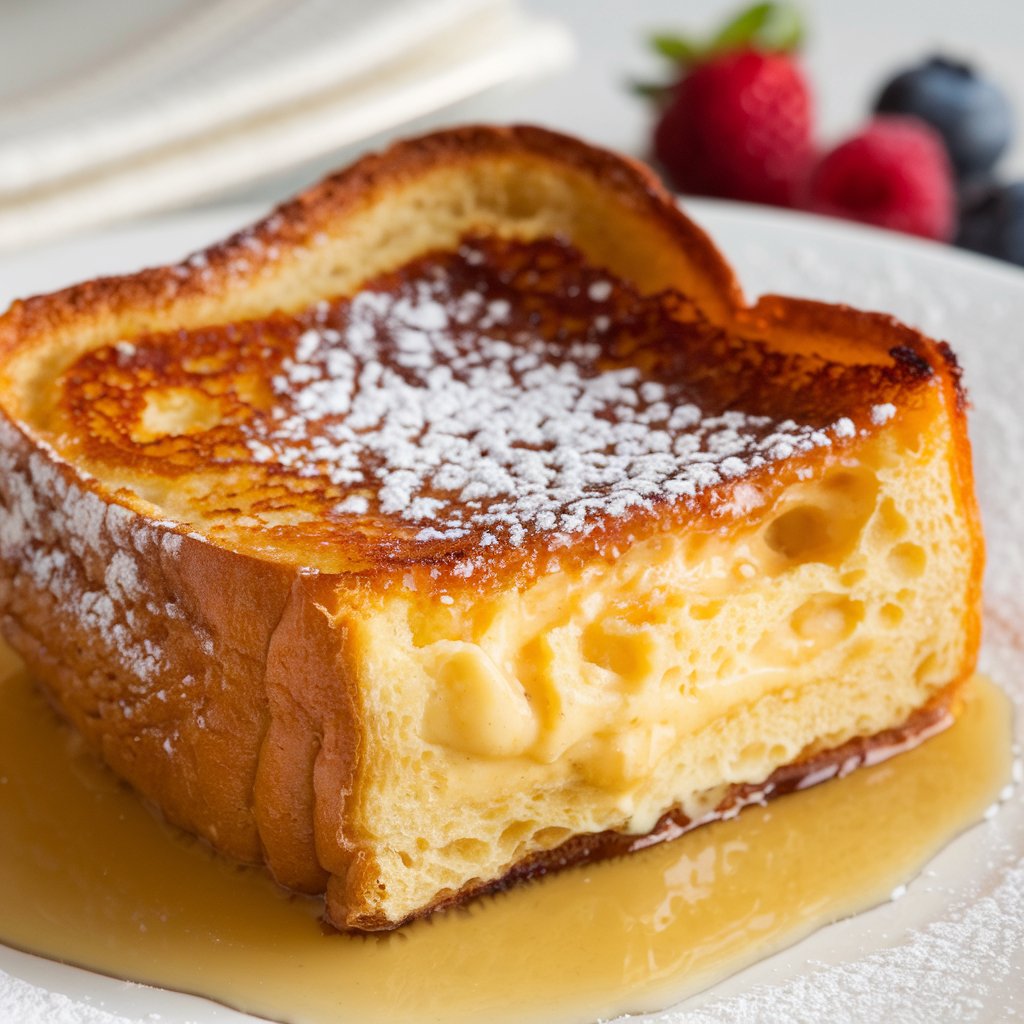Few dishes evoke as much morning comfort as French toast. Golden, crisp, and slightly sweet, this iconic breakfast delicacy has roots stretching back to ancient Rome. Over the centuries, it has evolved into a culinary marvel, with various twists, toppings, and even different bread types enhancing its already versatile appeal. While many rely on classic sandwich bread, using a French baguette or festive Stollen elevates the experience to gourmet status.
Let’s explore how French toast made with a crusty baguette or the rich, fruit-filled Stollen can completely transform your morning.
The Art of French Toast
French toast, or “pain perdu” in French, literally translates to “lost bread.” Its origins lie in the idea of reviving stale bread, a thrifty practice that gave way to a culinary tradition. The concept is simple: slices of bread soaked in a mixture of beaten eggs and milk, then pan-fried to golden perfection. Over time, the dish has been enhanced with sugar, spices, and a range of toppings, making it a beloved breakfast or brunch item worldwide.
Choosing the right bread is crucial. Most people opt for brioche or thick white bread, but today we’ll focus on the French baguette, with its crusty exterior and chewy center, and Stollen, a rich, dense German bread packed with fruits and spices.

Why You Should Use a Baguette for French Toast
Baguettes offer a delightful twist to French toast, transforming the texture and taste profile entirely. The crunchy crust of a baguette adds an appealing contrast to the soft, custard-like interior that develops when the bread soaks up the egg mixture.
When using a baguette, it’s essential to cut the slices thick—at least one inch. This thickness ensures that the bread soaks up just the right amount of egg mixture without becoming soggy. The result is a slice of it that is both crunchy and creamy, offering the perfect bite every time.
Stollen: A Festive Take on French Toast
Stollen is traditionally associated with Christmas, but why limit it to just one season? With its rich flavor profile—packed with dried fruits, marzipan, and nuts—Stollen French toast adds a celebratory touch to any breakfast table.
Because Stollen is naturally denser than other bread, it absorbs less of the egg mixture but retains more flavor. The fruits and spices, combined with the buttery richness of the bread, turn each bite into a complex and delightful experience. Paired with a dusting of powdered sugar or a drizzle of warm honey, Stollen French toast becomes an indulgent treat that’s perfect for a special occasion or a lazy weekend morning.
How to Make Perfect French Toast with Baguette or Stollen
Whether you choose a French baguette or Stollen, the method for making it remains largely the same, though with minor adjustments based on the bread’s density and absorption rate.
Ingredients for French Toast with Baguette or Stollen
- 1 loaf of day-old baguette (sliced thick) or Stollen
- 3 large eggs
- 1 cup whole milk (or cream for a richer toast)
- 1 tsp vanilla extract
- 1 tsp cinnamon (optional but highly recommended)
- 1 tbsp sugar
- A pinch of salt
- Butter for frying
- Toppings: powdered sugar, syrup, fresh fruit, whipped cream

Step-by-Step Instructions for making
- Prepare the Egg Mixture
In a large mixing bowl, whisk together the eggs, milk, vanilla extract, cinnamon, sugar, and salt until well combined. This mixture should be slightly thick and well-flavored, as it’s what will infuse the bread with all the deliciousness. - Soak the Bread
For baguettes, soak each slice for about 20-30 seconds per side, ensuring that the bread absorbs the mixture without becoming too mushy. With Stollen, you’ll want to soak the slices for a bit less time, around 10-15 seconds per side. - Heat the Pan
Place a non-stick skillet or griddle over medium heat and add a generous pat of butter. Once the butter is sizzling, it’s time to cook the toast. - Fry the Bread
Place the soaked slices of bread in the pan and cook for 2-3 minutes on each side, or until golden brown and slightly crispy. Adjust the heat as necessary to prevent burning. - Serve Hot
Serve the French toast hot, topped with your favorite toppings. If you’ve made Stollen French toast, a simple dusting of powdered sugar or a drizzle of maple syrup will complement the bread’s richness. Baguette French toast pairs beautifully with fresh berries and whipped cream.
Toppings for the Ultimate French Toast Experience
The beauty of it lies not only in the bread but also in the toppings you choose. Whether you like your toast simple or decadent, here are some ideas to elevate your dish:
- Fresh Fruit: Berries, bananas, or even citrus slices add freshness and a touch of acidity that cuts through the richness.
- Whipped Cream: Light and airy, whipped cream is the perfect counterbalance to the crisp toast.
- Nuts: A handful of toasted almonds or pecans provides a delightful crunch.
- Maple Syrup: Classic and timeless, a drizzle of real maple syrup enhances the flavor without overpowering it.
- Honey: For those who prefer a more floral sweetness, honey pairs exceptionally well with both baguette and Stollen French toast.
French Toast Variations Across Cultures
Interestingly, French toast has been adapted in many cultures around the world, each putting its unique spin on this breakfast staple.
- Pain Perdu (France): The original French version of French toast, often made with day-old baguettes, is served simply with sugar or jam.
- Torrijas (Spain): Torrijas are similar to it but are typically soaked in milk and honey, sometimes with a splash of wine. This Spanish version is often served during Lent.
- Arme Ritter (Germany): In Germany, it is known as “poor knights” and is typically served with fruit or jam.
These global variations highlight the universal appeal of French toast and how versatile it can be. Whether you stick with the French baguette, opt for Stollen, or experiment with other types of bread, you can always discover new flavors and textures.

Stollen vs. Baguette: Which Bread is Best for French Toast?
If you’re wondering whether to use Stollen or baguette for your French toast, the answer depends on your preferences. For a classic experience with a bit more crunch, the baguette is an excellent choice. It allows for a more traditional French toast with a slight rustic edge. Stollen, on the other hand, offers a more indulgent experience. The fruit and spices create a complex and flavorful dish that can feel like dessert for breakfast.
Both breads bring something unique to the table, and trying them out will provide you with two completely different takes on the same dish.
FAQs
What’s the best type of bread for French toast?
Brioche, challah, or baguette are considered excellent choices due to their ability to soak up the egg mixture without becoming soggy. For a unique twist, Stollen works beautifully for special occasions.
How can I avoid soggy French toast?
Make sure your bread is slightly stale, or let fresh bread sit out overnight. Also, don’t soak the bread too long—about 20-30 seconds per side is ideal for most bread types.
Can I use milk alternatives for French toast?
Absolutely! Almond milk, coconut milk, or even oat milk can be used in place of traditional milk. These alternatives may slightly change the flavor but still yield delicious results.
What toppings go best with French toast?
Classic toppings like powdered sugar, syrup, and fresh fruit are always popular. For a richer version, try whipped cream, chocolate sauce, or nuts.
Is French toast healthy?
French toast can be part of a balanced diet when consumed in moderation. Opt for whole grain bread, use minimal sugar, and top with fresh fruit for a healthier version.
Can I make French toast ahead of time?
Yes, French toast can be made ahead and stored in the refrigerator for up to two days. Reheat in a toaster or oven for the best texture.
Conclusion
French toast is more than just a way to use up stale bread—it’s a beloved dish that has stood the test of time. Whether you choose to use a French baguette or opt for a festive Stollen, you can’t go wrong with this classic breakfast treat. Experiment with different toppings and types of bread to find your perfect version. No matter how you enjoy it, French toast remains a timeless favorite for breakfast or brunch.



